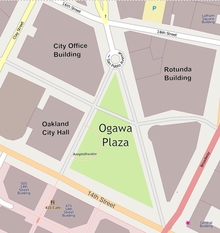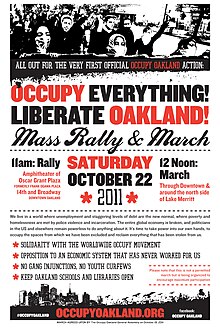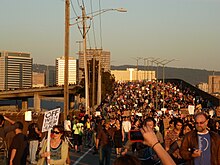Occupy Oakland
[9] Occupy Oakland planned and organized a number of direct actions including marches and rallies and guest speakers to build support for the movement.[11] On October 17, the three American hikers recently freed from an Iranian prison made their first West Coast speaking appearance at Occupy Oakland, drawing an audience of around 300 people.[citation needed] The American Civil Liberties Union and National Lawyers Guild called for an investigation into the use of alleged use of excessive force by some Oakland police officers.[35] Mayor Jean Quan issued a statement urging non-violence and asked that there be no overnight camping, however the city did not take steps to prevent protesters from re-occupying the plaza.[49] Thousands of protesters gathered at the plaza on November 2 to participate in rallies, marches, and teach-ins designed to draw attention to economic inequity and corporate greed as part of the 2011 Oakland General Strike.Demonstrators took down fences and set up tents, hung banners, and had an impromptu dance session in the rain, powered by a sound truck."[9] Mayor Jean Quan visited the protest site the next day on October 11, 2011, and according to KCBS, condoned the occupation but asked that campers not urinate on plaza's large oak tree because it has shallow roots.[96] The next day, October 20, the City of Oakland published and distributed an official notice of violation citing the camp for fire, safety, and sanitation hazards.[98][99][100] The 300 to 400 demonstrators "appeared determined not to leave" and countered that "complaints about rats, drug crimes and violence in the area of 14th Street and Broadway went unchecked before they arrived.On October 25, 2011, Scott Olsen, a 24-year-old former Marine and Iraq War veteran, suffered a skull fracture caused by a projectile that some witnesses claimed was a tear gas or smoke canister fired by police.[citation needed] The American Civil Liberties Union and National Lawyers Guild are calling for an investigation into the alleged use of excessive force by Oakland police.Masked vandals shattered windows, set fires and plastered downtown businesses with graffiti before police moved in, dispersing crowds with tear gas and flash-bang grenades and making dozens of arrests.[132] During the evening march to the Port of Oakland as part of the general strike on November 2, protesters were struck by a car in an incident recorded on video.[141] After her release, Yael Chanoff of the San Francisco Bay Guardian, alleged that she had witnessed police brutality and cruel treatment of prisoners in custody.[145] Protesters have also been recorded throwing bottles, metal pipe, rocks, spray cans, improvised explosive devices, and lighting flares at police.On the night of January 28, 2012, Occupy Oakland protesters reconvened at Frank Ogawa Plaza, entered and vandalized City Hall, following the day of clashes during which 409 were arrested.[152][153] Protesters also smashed display cases, broke down doors, overturned vending machines, damaged a classroom, cut wires in the building and sprayed graffiti inside.[159] Three Occupy Oakland members faced charges of felony robbery and hate crimes stemming from a February 22 event where they allegedly battered and robbed a woman.[160] According to the Oakland police, she was then surrounded by protesters Michael Davis, 32, Nneka Crawford, 23, and Randolph Wilkins, 24, "and battered as they yelled vulgar epithets regarding their perception of her sexual orientation"[161] before taking her wallet.South Africa Project has attracted controversy as an alleged white supremacist group, and Occupy members claimed they had ties to Ku Klux Klan leader David Duke.[150] Occupy Oakland began on October 10, 2011, with a rally attended by hundreds and protest encampment of a couple dozen tents at Frank Ogawa Plaza.[11] Beginning October 20, City officials distributed notices to the protesters citing "violence, assaults, threats and intimidation", among other complaints, and, forbidding lodging overnight.[167] The demonstrators "appeared determined not to leave" and countered that "the rats, drug crimes, and violence in the area of 14th Street and Broadway went unchecked before [Occupy Oakland] arrived."[101] On October 25, 2011, police officers in riot gear from various Bay Area law enforcement agencies cleared the plaza and Snow Park during the early hours of the day.[102] Thousands of protesters gathered at Frank Ogawa Plaza to participate in rallies, marches, and teach-ins designed to empower citizens and to draw attention to economic inequity and corporate greed as part of the 2011 Oakland General Strike.[172] In mid-November, the city administrator's office authorized an emergency expenditure of $300,000 to employ VMA, a private security firm, to guard against further encampments by Occupy Oakland.On December 6, Oakland City Council declined to support paying additional funds to VMA, the private security firm charged with guarding against encampments at Frank Ogawa Plaza.[173] On Saturday, January 28, a crowd of approximately 500 Occupy Oakland protesters unsuccessfully attempted to break into the historic Henry J. Kaiser Convention Center.This action was taken in spite of the City of Oakland's repeated advisements that peaceful assemblies, protests, and marches would be facilitated, but that the illegal breaking and entering into buildings or other criminal acts will not be tolerated.On February 7, Oakland City Council held a public meeting to consider recommendations from Councilmembers Ignacio De La Fuente and Libby Schaaf to: Adopt A Resolution Opposing Any Purposeful Upcoming Or Future Port Of Oakland Shut-Downs, Directing The City Administrator And Urging The Mayor To Use Whatever Lawful Tools We Have, Including Enforcement Of State Laws And Local Municipal Code Regulations And Requirements, To Prevent Future Shut Downs Or Disruptions Of Any Port OperationsThe resolution failed to pass.





Occupy movementOaklandCaliforniaWealth inequalityCorporatocracypolice misconductOccupationPicketingGeneral StrikeRiotingOakland Police DepartmentJean QuanHoward JordandemonstrationsoccupationsFrank H. Ogawa PlazaOakland City HallOscar GrantBay Area Rapid Transit PolicePort of Oaklandshot and killedJohannes MehserleIndigenous People's DayOccupy Wall Streetdirect actionsDanny Gloverthree American hikers recently freed from an Iranian prisonbicycleLupe FiascoCésar ChávezBerkeleyUC BerkeleySan FranciscoSan JoseAlameda County Sheriff's OfficeSan Francisco Sheriff's DepartmentSanta Clara County Sheriff's OfficeCalifornia Highway PatrolOakland Public Librarytear gasbeanbag roundsM-80 firecrackersskull fractureprojectileAmerican Civil Liberties UnionNational Lawyers Guildprotest campCalifornia Nurses AssociationMichael MooreTahrir SquareOccupy Cal2011 Oakland general strikeUptownKaiser Convention Centerimprovised explosive devicesThe Newspaper GuildOccupied Wall Street JournalBay Area News GroupOakland Tribunecease and desistDesley BrooksU.S. CongressBarbara LeePete StarkAlameda CountyNancy NadelIgnacio De La FuentePatricia KernighanLibby SchaafMarineIraq WarAssociated PressThe Guardianbean bag roundcritical conditionadministrative dischargeThe Ed ShowThe Rachel Maddow ShowCurrent TVCountdown with Keith OlbermannCampbell v. City of OaklandHighland HospitalSusie CagleABC NewsMother JonesVivian HoSan Francisco ChronicleEast Bay ExpressSan Francisco Bay Guardiancorrugated metalOccupy SacramentoEast OaklandBoycott, Divestment and SanctionsIsraelJweeklySouth AfricaCalifornia State Capitolwhite supremacistKu Klux KlanDavid DukeTimeline of Occupy OaklandTimeline of Occupy Wall Streetriot gearBay Arealess lethalimmigrant detention centersOakland City CouncilJane BrunnerRebecca KaplanAlan BluefordOakland PoliceList of global Occupy protest locationsWe are the 99%Occupy the Farm2011 United States public employee protests2011 Wisconsin protestsTea Party protestsList of incidents of civil unrest in the United StatesAllen v. City of OaklandLibrary of CongressThe New York TimesHuffington Postmsnbc.comWayback MachineThe Christian Science MonitorChris Hedges